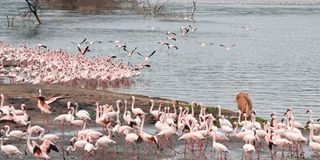You can take a dip at the hot water spring at Lake Bogoria, but not swim

Flamingos at Lake Bogoria National Reserve in Baringo County, one of the tourists’ attraction sites in the county. Photo | Jared Nyataya
What you need to know:
You can take a dip at the hot water spring at Lake Bogoria, but not swim
It’s a picturesque drive setting off from Nairobi at the crack of dawn to reach the flamingo-filled Bogoria by mid-morning. It’s half-way through October, the rainy month and turning off from Nakuru to take the road deeper into the Great Rift, it’s lush grass fields juxtaposed with the farmers’ fields to the equator at Mogotio. The road is lined with many species of acacias, euphorbias and other tough plants that can hold their might against the blistering sun.
Coming over the ridge, a sheen of water reveals the fresh-water lake Baringo, our final destination for the night. “Where is Bogoria,” asks a perplexed Anil Bhandari, an alumni of the University of Nairobi in 1971. The Tanzanian-born is on his first safari to lands beyond the equator into Kenya’s fascinating northern drylands.
He may have missed it, if he was not in good company (but there always Googlemap to direct you anywhere) because in 1883, the intrepid Joseph Thomson who camped at Baringo on his epic walk from the coast to the Nyanza in search of a direct route that is the modern-day road from Mombasa to Lake Victoria, never saw it and had no inkling of the caustic cauldron that at the time i.e. 118 years ago, was some 25 kilometres south.
Turning in from Marigat, the increasingly busy town of Baringo county, the road winds down to the lake with the red soil showing amongst the towering chimney-shaped termite mounds, volcanic rocks and cliffs, lush swamps and hidden springs with the honey sellers tempting all to stop.
Suddenly the road is barricaded with dry thorn bush. Bogoria’s more than twice its size since the phenomenal rise of all the Great Rift lakes from a decade ago. It’s swallowed the tarmac road and the main gate which means we can’t reach the salt pan.
Diverting to the higher road, caustic Bogoria’s flaming with flamingos under a searing blue sky flanked by the Laikipia plateau. The water’s a jade green brimming with algae, Spirulina platensis that is the pretty pink birds’ favourite food and responsible for its colour. The Greater Flamingo pale in comparison, taller and whiter, but still pretty and far out-numbered by the lesser. They hold their own court nearer the fresh springs by the edges of the lake.

A local tourist enjoys steam from a geyser at Lake Bogoria National Reserve in Baringo County. Photo| Jared Nyataya
A monitor lizard scuttles away in the scrub but it’s the pink of the flamingos that catches the eye, at times strewn like petals in deeper waters, at times strung like skeins and in some parts so tightly packed that they look like ballerinas in pink tutus jostling for space. It’s a scene to behold, a treat for the eyes.
No wonder the ancient Egyptians believed that the beautiful bird was a re-incarnation of Ra, the Sun God. I’m reading for the umpteenth time the 1995 book by Marguerita North Lewis titled ‘A Guide to Lake Baringo and Lake Bogoria’. Despite its age, it’s an indispensible guide to the ancient lakes. It reveals more fascinating facts about the ancient bird like the first paintings of flamingos are found in the Spanish caves from 5,000 years ago and that the modern-day flamingos have been flying around for fifty million years as evidence from fossils.
And yet we know so little about them. Their flight patterns are still a mystery for such big birds.
A Greater kudu with his spiralling horns shows for a split second through the bushes. Driving deeper into the reserve to reach the hot water geysers at Loburu, some 18 kilometres from the gate, the flowering trees like the Terminalia Spinoza that’s termite resistant and used as poles in the huts now being replaced by modern stone or mabati dwellings, are hung with bee hives. A female herd of Greater kudus stand with the young in the bushes, frustrating because they are hard to photograph.
Reading the book again, Lewis writes that Bogoria is named after an ancient people who are now extinct. And the wildlife like the striped hyena, silver-backed jackals, aardvarks and most surprising the big cats like lion, leopard and cheetah no longer exist here. Where are they now. I wonder?
Go to Bogoria
It’s an easy 5-hour drive on tarmac from Nairobi.
Call Patrick Kurere of Friends of Nature Bogoria 0720 385096 for bird guides (more than 150 species besides flamingos) and any other info.
A cheap but cheerful place to stay is at Netbon Ecotourism Kudu Camp 0723 362 546 or 0722 611 326. Take your food. There’s a hot-water spring to bathe in.
From here you can drive to Baringo and further north to Kapedo; or west to Iten, Eldoret and beyond.
Finally – you CANNOT swim in Bogoria.
www.rupitheafricantrotter.com




